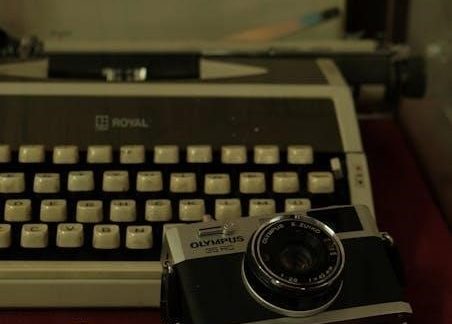Writing about film demands a blend of critical thinking and creative insight. It involves analyzing themes, characters, and visual elements to uncover deeper meanings and evaluate storytelling techniques effectively.
The Importance of Film Analysis
Film analysis is essential for understanding the deeper layers of storytelling, themes, and cultural reflections in cinema. It allows viewers to move beyond surface-level entertainment, uncovering the director’s intent and the film’s emotional resonance. By examining elements like cinematography, dialogue, and editing, analysts can evaluate how these components shape the narrative and evoke audience responses. Film analysis also fosters critical thinking and communication skills, as it requires articulating observations and supporting arguments with evidence. Moreover, it bridges the gap between film and its historical or social context, revealing how movies reflect or challenge societal norms. Ultimately, film analysis enriches our appreciation of cinema as an art form and a medium for storytelling, making it a vital tool for both scholars and casual viewers alike.
Key Components of Film Criticism
Film criticism involves evaluating various aspects of a film to provide insightful commentary. Key components include analyzing the plot structure, character development, and dialogue to assess storytelling effectiveness. Critics also examine visual elements like cinematography, lighting, and editing, which contribute to the film’s tone and atmosphere. Sound and music are evaluated for their role in enhancing emotional impact. Additionally, the director’s vision and themes are scrutinized to understand the film’s message. Cultural and social contexts are considered to gauge relevance and representation. Effective criticism balances objective analysis with subjective interpretation, providing readers with a comprehensive understanding of the film’s strengths and weaknesses. By focusing on these elements, critics offer valuable perspectives that deepen audience appreciation and understanding of cinema.
Developing a Critical Eye
Cultivating a critical eye for film analysis requires intentional practice and observation. Start by closely examining visual elements such as composition, lighting, and camera angles, which convey mood and narrative clues. Pay attention to how editing influences pacing and tension. Listen to dialogue for its emotional resonance and character development. Consider the film’s themes and how they resonate with personal experiences. Reflect on cultural and social contexts that shape the story. Practice articulating observations clearly and support opinions with specific examples. Over time, this skill enhances your ability to interpret films deeply and share insightful critiques. Regularly engaging with diverse cinematic styles and genres further sharpens your critical perspective, making you a more discerning and thoughtful film analyst.
Film Analysis
Film analysis involves examining visual elements, sound, plot, and character development to interpret themes, tone, and the filmmaker’s intent, offering deeper insights into the cinematic experience.
Understanding the Purpose of Film Analysis
Film analysis serves to uncover the underlying themes, motifs, and messages embedded in a film, offering insights into the director’s vision and societal contexts. It involves deconstructing cinematic elements like visuals, sound, and dialogue to interpret meaning. By examining these components, analysts can explore how films reflect or challenge cultural norms, historical events, or psychological complexities. The goal is to move beyond surface-level entertainment, delving into the artistic and ideological layers that shape the narrative. Effective film analysis enhances understanding, fostering deeper appreciation and critical engagement with the medium. It also encourages viewers to consider the broader implications of storytelling in visual media, making it a valuable tool for both scholars and audiences alike.
Key Elements to Analyze in a Film
When analyzing a film, focus on key elements such as plot, character development, cinematography, sound, and themes. The plot structure reveals how the narrative unfolds, while character development explores motivations and growth. Cinematography examines lighting, framing, and camera techniques that shape the visual tone. Sound, including music and dialogue, enhances emotional impact and storytelling. Themes represent the underlying ideas or messages the film conveys. Additionally, consider the director’s style, cultural context, and historical background, as these influence the film’s meaning. By examining these elements, you can uncover the film’s artistic intent and its resonance with audiences. This comprehensive approach ensures a deeper understanding of the film as a cultural and artistic medium.
Common Mistakes to Avoid in Film Analysis
When writing a film analysis, avoid common pitfalls such as excessive plot summarization, which detracts from critical insight. Refrain from mixing reviews with analysis; focus on interpreting themes and techniques rather than merely expressing opinions. Overlooking visual and auditory elements like lighting, sound, and editing can lead to a superficial analysis. Additionally, neglecting the historical or cultural context of a film limits its interpretative depth. Ensure your analysis is well-supported with evidence from the film, avoiding vague statements. Maintaining a clear, focused argument and organizing your ideas logically are essential for a compelling analysis. By steering clear of these mistakes, you can produce a nuanced and insightful film analysis that contributes meaningfully to the discussion of cinematic art.
How to Analyze Visual Elements in Film
Analyzing visual elements in film involves examining cinematography, lighting, color, and composition to understand their impact on storytelling. Pay attention to how lighting sets the mood, with high contrast creating drama or low-key lighting evoking mystery. Color schemes can symbolize themes, such as warm tones for nostalgia or cool tones for detachment; Composition, including framing and camera angles, guides viewer focus and conveys character emotions. For instance, low-angle shots may signify power, while close-ups emphasize intimacy. Consider how these visual choices align with the film’s narrative and themes. Taking detailed notes during multiple viewings helps capture these elements. By systematically breaking down the visual language, you can uncover layers of meaning that enhance your analysis and deepen your understanding of the film’s artistic vision.
Researching the Historical Context of a Film
Researching the historical context of a film involves exploring the cultural, social, and political climate of the era in which it was produced and set. This includes examining the filmmaker’s background, the audience’s expectations, and the historical events that influenced the narrative. For instance, a film set during a war may reflect the anxieties or propaganda of that time. Understanding the context helps identify themes, motifs, and symbols that resonate with the period. Additionally, analyzing the film’s production history, such as budget constraints or technological limitations, can provide insights into its visual and storytelling choices. By connecting the film to its historical backdrop, viewers can better appreciate its relevance and the message it conveys, enriching their analysis and interpretation of the cinematic work.

Screenwriting Basics
Screenwriting involves crafting a compelling narrative with well-defined characters, dialogue, and structure. It requires a clear vision, attention to pacing, and the ability to engage audiences visually and emotionally.
The Basics of Screenwriting
Screenwriting is the foundation of filmmaking, requiring a unique vision and detailed planning. It involves crafting a compelling narrative, developing characters, and structuring scenes to engage audiences emotionally and visually. A screenplay serves as a blueprint for production, guiding directors, actors, and crew. Key elements include dialogue, pacing, and visual descriptions that bring stories to life. Screenwriters must balance creativity with technical precision, ensuring scripts are concise and impactful. Understanding cinematic techniques, genre conventions, and audience expectations is crucial. The process often involves revisions, collaboration, and a deep understanding of storytelling principles.
Crafting a Compelling Plot
Crafting a compelling plot is essential for engaging audiences and driving the narrative forward. A strong plot typically includes a clear structure: exposition, rising action, climax, and resolution. Conflict is the engine of any story, whether internal or external, and should escalate tension to maintain interest. The protagonist’s journey and character development should be intertwined with the plot’s progression. Effective pacing balances action and downtime, ensuring the story unfolds naturally. Subplots can enrich the narrative but must tie back to the main storyline. Foreshadowing and twists add depth and surprise, keeping viewers invested. Drawing inspiration from real-life events or universal themes can enhance relatability. Finally, revising and refining the plot ensures coherence and eliminates unnecessary elements, creating a polished and immersive cinematic experience.
Developing Believable Characters
Creating believable characters is crucial for engaging audiences and making your story relatable. Characters should have well-defined traits, motivations, and backstories to feel authentic. Give them unique personalities, flaws, and strengths to avoid stereotypes. Dialogue should reflect their individual voices and backgrounds. Character arcs are essential, showing growth or transformation throughout the story. Ensure their actions and decisions align with their established traits. Avoid making characters overly perfect or one-dimensional. Provide opportunities for characters to express emotions and vulnerabilities, making them more human. Balance dialogue with subtle actions and expressions to convey depth. Finally, test your characters by imagining how they would react in different scenarios to ensure consistency and believability. Strong characters can elevate your film, making it memorable and impactful for viewers.
Writing Effective Dialogue
Effective dialogue is essential for engaging storytelling, as it reveals character traits, advances the plot, and enhances emotional depth. Dialogue should sound natural, reflecting how people speak in real life while avoiding unnecessary exposition. Each character’s voice should be distinct, mirroring their personality, background, and motivations. Avoid forced or overly formal language unless it fits the character’s persona. Use subtext to imply underlying emotions or conflicts, adding layers to conversations. Balance dialogue with action and description to maintain pacing. Read your dialogue aloud to ensure it feels authentic and flows smoothly. Finally, edit ruthlessly, removing any lines that don’t serve the story or deepen character understanding. Well-crafted dialogue can elevate your film, making it more immersive and memorable for audiences.

Elements of Film
Film elements include visual components like lighting, color, and composition, as well as sound effects, dialogue, and music, all working together to create a cohesive cinematic experience.
Visual Elements in Film
Visual elements are fundamental in filmmaking, as they convey mood, setting, and character depth. Lighting, for instance, can create dramatic contrasts, guiding the audience’s focus and evoking emotions. Color palettes and composition frame the visual storytelling, while camera angles, such as close-ups or wide shots, influence perspective and tension. Mise-en-scène, including costumes, props, and set design, immerses viewers in the film’s world. These visual components work together to enhance the narrative, making the cinematic experience more engaging and layered. By analyzing these elements, viewers can uncover subtle themes and appreciate the director’s artistic vision; Understanding visual storytelling is essential for both filmmakers and critics, as it shapes the emotional and intellectual impact of a film.
The Role of Sound and Music
Sound and music are vital elements in filmmaking, enhancing the emotional impact and narrative depth. Sound effects create a realistic environment, like explosions in action films, making scenes feel intense. The score, composed specifically for the film, sets the mood and guides emotions—horror movies rely on eerie soundtracks to build tension. Pre-existing songs can resonate with themes or evoke familiarity, affecting the audience’s reaction. Dialogue delivery, including tone and pacing, contributes to the scene’s feel, while sound mixing balances elements like dialogue and background noise. Historically, sound has evolved from silent films with live music to complex designs in modern blockbusters. Genre-specific sound use, such as upbeat music in comedies or suspenseful scores in thrillers, sets audience expectations. Creatively, sound can foreshadow events or build suspense, like amplified footsteps before a revelation. Overall, sound and music are essential for a compelling cinematic experience, enhancing visual elements and storytelling.
Understanding Film Editing Techniques
Film editing is the backbone of storytelling in cinema, shaping the narrative and emotional impact through the arrangement of scenes. Editors use techniques like scene transitions, pacing, and tone to guide the audience’s experience. Techniques such as cross-cutting create suspense by alternating between parallel storylines, while slow motion emphasizes dramatic moments. The choice of shots, from close-ups to wide angles, influences emotional depth and visual storytelling. Sound integration, including dialogue and music, enhances the mood. Continuity editing ensures seamless transitions, maintaining audience immersion. Special effects and CGI are also edited to blend seamlessly with live-action footage. By mastering these techniques, editors transform raw footage into a cohesive, engaging film that resonates with viewers. Understanding editing is crucial for analyzing how films convey their intended message and atmosphere.
The Importance of Narrative Structure
Narrative structure is the foundation of storytelling in film, providing a clear framework for engaging audiences and conveying themes effectively. A well-crafted narrative guides viewers through the story, building tension and resolving conflicts. The classic three-act structure—setup, confrontation, and resolution—is widely used to create a logical flow. Each act serves a purpose: the setup introduces characters and conflicts, the confrontation develops tension, and the resolution provides closure. Effective narrative structure enhances emotional impact, ensuring the story resonates with viewers. It also allows filmmakers to explore complex ideas and themes cohesively. A strong structure is essential for maintaining audience engagement and delivering a memorable cinematic experience. By understanding and mastering narrative structure, filmmakers can craft compelling stories that leave a lasting impression.

Film Genres
Film genres categorize movies by themes, styles, and emotional appeals, guiding storytelling and audience expectations. Major genres like comedy, thriller, and drama shape narratives, ensuring relatable experiences.
Major Film Genres and Their Characteristics
Major film genres include comedy, thriller, drama, and horror, each with distinct traits. Comedy focuses on humor and happy endings, while thrillers build suspense to captivate audiences. Drama explores realistic human experiences, often delving into emotional depth. Horror aims to evoke fear and tension through eerie settings and unsettling narratives. These genres provide a framework for storytelling, helping filmmakers convey their visions and audiences anticipate themes. Understanding these categories enhances analysis and appreciation of cinematic works, as they reflect cultural and social influences. Genre blending has become common, allowing for unique storytelling that appeals to diverse viewers. Recognizing these elements is crucial for effective film criticism and analysis.
How Film Genres Evolve Over Time
Film genres evolve over time, reflecting societal changes, technological advancements, and shifting audience preferences. For instance, comedy emerged as a pioneer genre, relying on humor and happy endings, while thrillers developed to captivate audiences with suspense. Historical events, like post-WWII anxieties, influenced the rise of film noir, characterized by dark narratives. Modern genres often blend elements, creating hybrid categories that appeal to diverse viewers. This evolution allows filmmakers to explore new themes and storytelling techniques, keeping genres relevant. As cultural contexts change, genres adapt, incorporating fresh perspectives and innovative visual styles. This dynamic process ensures that film genres remain a vital part of cinematic storytelling, continually engaging audiences with fresh and compelling narratives.
Mixing Genres in Film
Mixing genres in film allows filmmakers to create unique storytelling experiences by blending elements from multiple categories. This approach can attract a broader audience by appealing to fans of different genres. For example, a sci-fi comedy combines futuristic themes with humor, offering both intellectual stimulation and entertainment. Genre mixing also enables directors to explore complex themes and emotions, as seen in horror-comedies that balance fear with laughter. Hybrid genres like rom-com (romantic comedy) or action-drama showcase how blending can refresh traditional narratives. By merging genres, filmmakers can innovate and challenge audience expectations, creating films that feel fresh and original. This technique not only enhances creativity but also reflects the diversity of modern storytelling, where boundaries are constantly being pushed and redefined.
How to Analyze Films by Genre
Analyzing films by genre involves understanding the conventions and expectations associated with specific categories like comedy, thriller, or horror. Start by identifying the film’s primary genre and its key characteristics, such as humor in comedy or suspense in thrillers. Examine how the film adheres to or subverts genre norms, and consider the audience’s expectations. Pay attention to visual and auditory cues, such as lighting or music, that reinforce genre identity. Evaluate how the film’s narrative, characters, and themes align with its genre while offering unique twists. This approach helps uncover how genres shape storytelling and viewer experiences. By focusing on genre-specific elements, you can better interpret the film’s purpose and its appeal to its target audience.

Critical Approaches to Film
Critical approaches to film involve applying theoretical frameworks, analyzing cultural contexts, and understanding audience reception to interpret meanings and evaluate cinematic works thoughtfully and ethically.
Theoretical Frameworks for Film Analysis
Film analysis can be enriched by applying various theoretical frameworks. For instance, auteur theory focuses on a director’s unique style, while genre theory examines how films fit into categories. Feminist theory explores gender dynamics, and postcolonial theory highlights cultural power imbalances. Additionally, psychoanalytic theory delves into subconscious themes, and marxist theory examines class struggles. These frameworks provide lenses to interpret films’ deeper meanings, enabling critics to uncover symbolic elements, societal reflections, and artistic intentions. By applying these theories, analysts can offer insightful, evidence-based interpretations, enhancing both academic and casual discussions about cinema.
Cultural and Social Contexts in Film
Films often reflect and shape cultural and social contexts, offering insights into the eras they depict or emerge from. Analyzing a film’s cultural background involves examining its setting, dialogue, and character behaviors, which mirror societal norms. For example, historical dramas like Schindler’s List portray specific cultural tensions, while films such as Parasite highlight class disparities. Additionally, comedy and thriller genres use humor and suspense to address cultural issues. Understanding these elements helps viewers connect films to broader social narratives, making cinema a powerful tool for cultural critique and storytelling. This approach enriches film analysis by linking artistic expression to real-world influences and audience experiences.
Understanding Audience Reception
Understanding audience reception is crucial in film analysis, as it reveals how viewers interpret and engage with a film. Audiences bring their own experiences, biases, and cultural backgrounds, influencing their reactions. Films like Inception sparked debates due to their complex narratives, while The Shawshank Redemption resonated emotionally, creating a loyal fan base. Audience reception can vary widely, shaped by factors like genre expectations, marketing, and cultural context. For instance, comedy films often rely on shared humor, while thrillers aim to evoke universal suspense. Analyzing this dynamic helps critics assess a film’s impact and appreciate its relevance to diverse audiences. By considering audience reception, writers can better evaluate how a film communicates its themes and connects with its viewers on an emotional and intellectual level, enriching the analysis with real-world perspectives and reactions. This approach bridges the gap between artistic intent and viewer experience, offering a comprehensive understanding of a film’s resonance and legacy.
Ethical Considerations in Film Criticism
Ethical considerations in film criticism ensure that reviews and analyses are fair, respectful, and transparent. Critics must avoid biases, personal attacks, or unfair judgments, focusing instead on the film’s artistic and technical merits. They should disclose potential conflicts of interest, such as personal connections to the filmmakers, to maintain credibility. Additionally, critics should be mindful of cultural sensitivities, avoiding stereotypes or offensive language. It’s important to distinguish between opinion and fact, ensuring that subjective interpretations are clearly stated. Ethical criticism also involves giving credit to the filmmakers and respecting intellectual property. By adhering to these guidelines, critics contribute to a constructive and respectful dialogue about film, fostering an environment where diverse perspectives can be shared and appreciated. This ethical approach enhances the integrity of film criticism and supports meaningful discussions within the film community.
